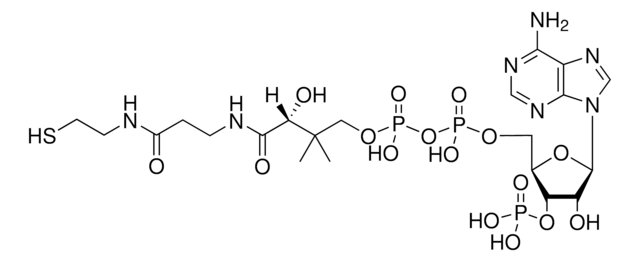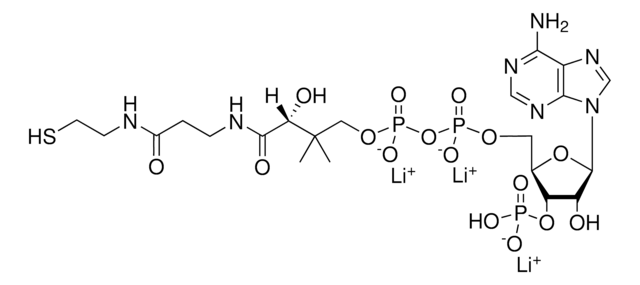About This Item
おすすめの製品
由来生物
yeast
アッセイ
≥85% (UV, HPLC)
形状
powder
官能基
phospholipid
輸送温度
ambient
保管温度
−20°C
SMILES記法
O.CC(C)(COP(O)(=O)OP(O)(=O)OC[C@H]1O[C@H]([C@H](O)[C@@H]1OP(O)(O)=O)n2cnc3c(N)ncnc23)[C@@H](O)C(=O)NCCC(=O)NCCS
InChI
1S/C21H36N7O16P3S.H2O/c1-21(2,16(31)19(32)24-4-3-12(29)23-5-6-48)8-41-47(38,39)44-46(36,37)40-7-11-15(43-45(33,34)35)14(30)20(42-11)28-10-27-13-17(22)25-9-26-18(13)28;/h9-11,14-16,20,30-31,48H,3-8H2,1-2H3,(H,23,29)(H,24,32)(H,36,37)(H,38,39)(H2,22,25,26)(H2,33,34,35);1H2/t11-,14-,15-,16+,20-;/m1./s1
InChI Key
TVSAELAFGDOPKI-BLPRJPCASA-N
アプリケーション
生物化学的/生理学的作用
注意
保管分類コード
11 - Combustible Solids
WGK
WGK 3
引火点(°F)
Not applicable
引火点(℃)
Not applicable
適用法令
試験研究用途を考慮した関連法令を主に挙げております。化学物質以外については、一部の情報のみ提供しています。 製品を安全かつ合法的に使用することは、使用者の義務です。最新情報により修正される場合があります。WEBの反映には時間を要することがあるため、適宜SDSをご参照ください。
Jan Code
C4282-100MG:
C4282-BULK:
C4282-VAR:
C4282-10MG:
C4282-25MG:
試験成績書(COA)
製品のロット番号・バッチ番号を入力して、試験成績書(COA) を検索できます。ロット番号・バッチ番号は、製品ラベルに「Lot」または「Batch」に続いて記載されています。
この製品を見ている人はこちらもチェック
ライフサイエンス、有機合成、材料科学、クロマトグラフィー、分析など、あらゆる分野の研究に経験のあるメンバーがおります。.
製品に関するお問い合わせはこちら(テクニカルサービス)












